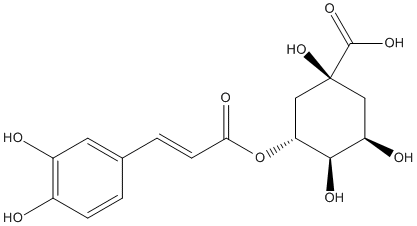Chlorogenic-acid
General
Type : Natural || Hydroxycinnamic-ester
Chemical_Nomenclature : (1S,3R,4R,5R)-3-[(E)-3-(3,4-dihydroxyphenyl)prop-2-enoyl]oxy-1,4,5-trihydroxycyclohexane-1-carboxylic acid
Canonical SMILES : C1C(C(C(CC1(C(=O)O)O)OC(=O)C=CC2=CC(=C(C=C2)O)O)O)O
InChI : InChI=1S\/C16H18O9\/c17-9-3-1-8(5-10(9)18)2-4-13(20)25-12-7-16(24,15(22)23)6-11(19)14(12)21\/h1-5,11-12,14,17-19,21,24H,6-7H2,(H,22,23)\/b4-2+\/t11-,12-,14-,16+\/m1\/s1
InChIKey : CWVRJTMFETXNAD-JUHZACGLSA-N
Other name(s) : CGA, Chlorogenic acid, 3-O-Caffeoylquinic acid, 3-(3,4-Dihydroxycinnamoyl)quinic acid, 3-Caffeoylquinic acid, CHEBI:16112, CHEBI:95271, CHEMBL284616, ZINC2138728, DB12029

References (11)
| Title : The effect of chlorogenic acid, a potential botanical insecticide, on gene transcription and protein expression of carboxylesterases in the armyworm (Mythimna separata) - Lin_2023_Pestic.Biochem.Physiol_195_105575 |
| Author(s) : Lin DJ , Zhang YX , Fang Y , Gao SJ , Wang R , Wang JD |
| Ref : Pestic Biochem Physiol , 195 :105575 , 2023 |
| Abstract : Lin_2023_Pestic.Biochem.Physiol_195_105575 |
| ESTHER : Lin_2023_Pestic.Biochem.Physiol_195_105575 |
| PubMedSearch : Lin_2023_Pestic.Biochem.Physiol_195_105575 |
| PubMedID: 37666601 |
| Title : A highly active esterase from Lactobacillus helveticus hydrolyzes chlorogenic acid in sunflower meal to prevent chlorogenic acid induced greening in sunflower protein isolates - Lo Verde_2022_Food.Res.Int_162_111996 |
| Author(s) : Lo Verde C , Pepra-Ameyaw NB , Drucker CT , Okumura TLS , Lyon KA , Muniz JC , Sermet CS , Were Senger L , Owens CP |
| Ref : Food Res Int , 162 :111996 , 2022 |
| Abstract : Lo Verde_2022_Food.Res.Int_162_111996 |
| ESTHER : Lo Verde_2022_Food.Res.Int_162_111996 |
| PubMedSearch : Lo Verde_2022_Food.Res.Int_162_111996 |
| PubMedID: 36461298 |
| Gene_locus related to this paper: lache-u6f2k7 |
| Title : Discovery and characterization of tannase genes in plants: roles in hydrolysis of tannins - Dai_2020_New.Phytol_226_1104 |
| Author(s) : Dai X , Liu Y , Zhuang J , Yao S , Liu L , Jiang X , Zhou K , Wang Y , Xie D , Bennetzen JL , Gao L , Xia T |
| Ref : New Phytol , 226 :1104 , 2020 |
| Abstract : Dai_2020_New.Phytol_226_1104 |
| ESTHER : Dai_2020_New.Phytol_226_1104 |
| PubMedSearch : Dai_2020_New.Phytol_226_1104 |
| PubMedID: 32061142 |
| Gene_locus related to this paper: camsi-a0a5b9g8c2 , jugre-JrTA , fraan-FaTA , vitvi-VvTA , citcl-CcTA , dioka-DkTA , camsi-CsTA |
| Title : A novel feruloyl esterase with high rosmarinic acid hydrolysis activity from Bacillus pumilus W3 - Liang_2020_Int.J.Biol.Macromol_161_525 |
| Author(s) : Liang W , Xiong T , Wang X , Deng H , Bai Y , Fan TP , Zheng X , Cai Y |
| Ref : Int J Biol Macromol , 161 :525 , 2020 |
| Abstract : Liang_2020_Int.J.Biol.Macromol_161_525 |
| ESTHER : Liang_2020_Int.J.Biol.Macromol_161_525 |
| PubMedSearch : Liang_2020_Int.J.Biol.Macromol_161_525 |
| PubMedID: 32531366 |
| Gene_locus related to this paper: 9baci-BpFae12 |
| Title : Hydrolysis of chlorogenic acid in apple juice using a p-coumaryl esterase of Rhizoctonia solani - Siebert_2019_J.Sci.Food.Agric_99_6644 |
| Author(s) : Siebert M , Berger RG , Pfeiffer F |
| Ref : J Sci Food Agric , 99 :6644 , 2019 |
| Abstract : Siebert_2019_J.Sci.Food.Agric_99_6644 |
| ESTHER : Siebert_2019_J.Sci.Food.Agric_99_6644 |
| PubMedSearch : Siebert_2019_J.Sci.Food.Agric_99_6644 |
| PubMedID: 31325326 |
| Title : Characterization of a feruloyl esterase from Aspergillus terreus facilitates the division of fungal enzymes from Carbohydrate Esterase family 1 of the carbohydrate-active enzymes (CAZy) database - Makela_2018_Microb.Biotechnol_11_869 |
| Author(s) : Makela MR , Dilokpimol A , Koskela SM , Kuuskeri J , de Vries RP , Hilden K |
| Ref : Microb Biotechnol , 11 :869 , 2018 |
| Abstract : Makela_2018_Microb.Biotechnol_11_869 |
| ESTHER : Makela_2018_Microb.Biotechnol_11_869 |
| PubMedSearch : Makela_2018_Microb.Biotechnol_11_869 |
| PubMedID: 29697197 |
| Gene_locus related to this paper: asptn-q0ci40 |
| Title : Evaluation of butyrylcholinesterase inhibitory activity by chlorogenic acids and coffee extracts assed in ITC and docking simulation models - Budryn_2018_Food.Res.Int_109_268 |
| Author(s) : Budryn G , Grzelczyk J , Jaskiewicz A , Zyzelewicz D , Perez-Sanchez H , Ceron-Carrasco JP |
| Ref : Food Res Int , 109 :268 , 2018 |
| Abstract : Budryn_2018_Food.Res.Int_109_268 |
| ESTHER : Budryn_2018_Food.Res.Int_109_268 |
| PubMedSearch : Budryn_2018_Food.Res.Int_109_268 |
| PubMedID: 29803450 |
| Title : A p-coumaroyl esterase from Rhizoctonia solani with a pronounced chlorogenic acid esterase activity - Nieter_2017_N.Biotechnol_37_153 |
| Author(s) : Nieter A , Kelle S , Linke D , Berger RG |
| Ref : N Biotechnol , 37 :153 , 2017 |
| Abstract : Nieter_2017_N.Biotechnol_37_153 |
| ESTHER : Nieter_2017_N.Biotechnol_37_153 |
| PubMedSearch : Nieter_2017_N.Biotechnol_37_153 |
| PubMedID: 28159727 |
| Gene_locus related to this paper: 9agam-x8iza2 |
| Title : Characterization of Cinnamoyl Esterases from Different Lactobacilli and Bifidobacteria - Fritsch_2017_Curr.Microbiol_74_247 |
| Author(s) : Fritsch C , Jansch A , Ehrmann MA , Toelstede S , Vogel RF |
| Ref : Curr Microbiol , 74 :247 , 2017 |
| Abstract : Fritsch_2017_Curr.Microbiol_74_247 |
| ESTHER : Fritsch_2017_Curr.Microbiol_74_247 |
| PubMedSearch : Fritsch_2017_Curr.Microbiol_74_247 |
| PubMedID: 27999938 |
| Gene_locus related to this paper: limf3-b2gdc2 , lache-u6f2k7 , bifa0-b8du06 , lacac-q5fi30 , lacga-q040s2 , lacpl-LP.2953 , lacre-q2bvr2 |
| Title : Role of bifidobacteria in the hydrolysis of chlorogenic acid - Raimondi_2015_Microbiolopen_4_41 |
| Author(s) : Raimondi S , Anighoro A , Quartieri A , Amaretti A , Tomas-Barberan FA , Rastelli G , Rossi M |
| Ref : Microbiologyopen , 4 :41 , 2015 |
| Abstract : Raimondi_2015_Microbiolopen_4_41 |
| ESTHER : Raimondi_2015_Microbiolopen_4_41 |
| PubMedSearch : Raimondi_2015_Microbiolopen_4_41 |
| PubMedID: 25515139 |
| Gene_locus related to this paper: bifa0-b8du06 |
| Title : A Chlorogenic Acid Esterase with a Unique Substrate Specificity from Ustilago maydis - Nieter_2015_Appl.Environ.Microbiol_81_1679 |
| Author(s) : Nieter A , Haase-Aschoff P , Kelle S , Linke D , Krings U , Popper L , Berger RG |
| Ref : Applied Environmental Microbiology , 81 :1679 , 2015 |
| Abstract : Nieter_2015_Appl.Environ.Microbiol_81_1679 |
| ESTHER : Nieter_2015_Appl.Environ.Microbiol_81_1679 |
| PubMedSearch : Nieter_2015_Appl.Environ.Microbiol_81_1679 |
| PubMedID: 25548041 |
| Gene_locus related to this paper: ustma-A0A0D1CFG4 |